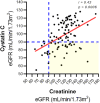Associations Between Characteristics of Individuals With Fontan Circulation With Blood and Urine Biomarkers of Kidney Injury and Dysfunction
- PMID: 37345835
- PMCID: PMC10356073
- DOI: 10.1161/JAHA.122.029130
Associations Between Characteristics of Individuals With Fontan Circulation With Blood and Urine Biomarkers of Kidney Injury and Dysfunction
Abstract
Background Fontan circulation is associated with kidney injury and dysfunction, often unappreciated until Fontan circulatory failure. We hypothesized that cystatin C-estimated glomerular filtration rate (eGFR) would identify chronic kidney disease more frequently and that urine kidney injury biomarkers would be higher with declining Fontan physiological features. Methods and Results We enrolled 100 ambulatory individuals. Blood and urinary laboratory measurements were compared with demographics and clinically obtained data. Different eGFR equations were used for individuals aged ≥19 years and <19 years. Chronic kidney disease was defined as eGFR <90 mL/min per 1.73 m2. Median (25th-75th percentile) age was 19 (14-26) years, and 43% were female patients. Cystatin C eGFR detected chronic kidney disease (37%) in more patients than creatinine eGFR (11%). Cystatin C eGFR was positively associated, and skeletal muscle mass was negatively associated, with creatinine eGFR in both univariate (cystatin C eGFR β=0.44±0.12, P=0.0006; skeletal muscle mass β=-0.72±0.32, P=0.03) and multivariable analysis (cystatin C eGFR β=0.43±0.12, P=0.0005; skeletal muscle mass β=-0.69±0.29, P=0.02). Urine neutrophil gelatinase-associated lipocalin concentration correlated with Fontan pressure (r=0.28; P=0.04), ventricular end-diastolic pressure (r=0.28; P=0.04), and body fat mass (r=0.26; P=0.03). Conclusions Cystatin C eGFR identified more kidney dysfunction, likely attributable to creatinine eGFR being confounded by skeletal muscle mass. Elevated urine neutrophil gelatinase-associated lipocalin was associated with worse Fontan hemodynamics and higher percentage body fat, suggesting that higher venous pressure and higher adiposity are associated with ongoing kidney injury.
Keywords: Fontan operation; adult congenital heart disease; chronic kidney disease; creatinine; cystatin C; hemodynamics; novel urine markers of kidney injury.
Figures


References
-
- Norozi K, Oechslin E. Renal dysfunction in adults with congenital heart defects. Prog Pediatr Cardiol. 2016;41:51–57. doi: 10.1016/j.ppedcard.2015.12.005 - DOI
-
- Kaddourah A, Goldstein SL, Basu R, Nehus EJ, Terrell TC, Brunner L, Bennett MR, Haffner C, Jefferies JL. Novel urinary tubular injury markers reveal an evidence of underlying kidney injury in children with reduced left ventricular systolic function: a pilot study. Pediatr Nephrol. 2016;31:1637–1645. doi: 10.1007/s00467-016-3360-2 - DOI - PMC - PubMed
Publication types
MeSH terms
Substances
LinkOut - more resources
Full Text Sources
Medical
Research Materials
Miscellaneous

